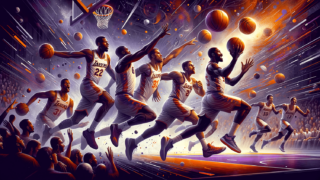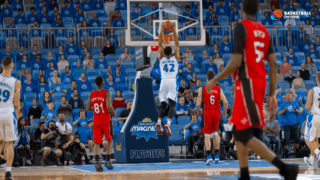
Are Jordans Good Basketball Shoes?
Written by: Basketball Universe
Last updated:

For many, the mention of basketball shoes instantly brings to mind the iconic Air Jordan brand, which has reigned supreme in the sneaker world for decades. But are Jordans really top-performers on the court, or is their notorious reputation more a result of clever marketing and the legendary status of their namesake, Michael Jordan? In our blog post, “Are Jordans Good Basketball Shoes?”, we’ll break down the tech, style, and performance behind these much-hyped kicks in order to answer that burning question. Whether you’re a seasoned baller or a casual fan, join us as we dive into the fascinating world of Jordans to determine their worthiness as a go-to option for basketball players at all skill levels.
Are Jordans Good Basketball Shoes?
Yes, Jordans are good basketball shoes. They offer excellent support, durability, and traction, making them ideal for on-court performance. While there are various models in the Air Jordan line, with some more suited for casual wear, many of the basketball-specific silhouettes integrate innovative technologies and materials designed to benefit players on the court. Additionally, the stylish designs and cultural significance of Jordans make them popular off-court as well, but their primary focus remains quality and performance in the game of basketball.
A Walk Down Memory Lane: The Evolution of Jordans
Before we delve into the performance aspects of various Jordan models, let’s take a trip down memory lane and explore how the brand has evolved over time. The first Air Jordan model, the Air Jordan 1, was introduced in 1985 when a promising young player named Michael Jordan joined the NBA. It represented a significant departure from traditional basketball sneaker designs and eventually turned out to be a game-changer, both literally and figuratively.
Air Jordan 1: The Beginning
Designed by Peter C. Moore, the Air Jordan 1 featured a high-top silhouette and the iconic Nike swoosh. Made with unique leather and textile combinations, it offered enhanced durability and comfort. The unconventional red and black colorway of the shoe quickly became a symbol of rebellion and uniqueness on the court, paving the way for its popularity off-court as well. Although not as technologically advanced as today’s Jordans, the Air Jordan 1 provided ample support, traction, and stability for basketball players.
Later Models: Technology Enters the Fold
As the years went on, each iteration of Jordans became more technologically advanced. With the introduction of new models, Jordan Brand consistently integrated cutting-edge innovations that improved upon their predecessors. Lightweight materials like knit fabrics, aerospace-inspired designs (such as the Jordan Flight Plate), and performance cushioning systems became defining features of the newer models.
An In-Depth Breakdown: Jordan Models and Performance
Now that we have delved into the history of Jordans, let’s take a closer look at the key features of some of the most iconic models in the line and how they fare on the basketball court.
Air Jordan 3: First to Feature Visible Air Sole
The third iteration in the line, the Air Jordan 3 introduced the visible Air Sole unit in the heel. Designed by legendary sneaker designer Tinker Hatfield, this model incorporated a supple leather upper and elephant-print accents. These elements combined to offer comfortable and lightweight support for basketball players, making it a performance-oriented shoe that successfully bridged the gap between on-court functionality and off-court style.
Air Jordan 11: The Ground-breaking Patent Leather Design
The Air Jordan 11 pushed the boundaries of sneaker design with its striking patent leather upper, which offered increased durability and a stylish look. It also became one of the most beloved models for on-court performance thanks to the introduction of the carbon fiber “Flight Plate” in the sole, which provided exceptional energy return and responsiveness. With added herringbone traction, basketball players could trust the grip and burst into action with confidence.
Air Jordan 13: The Panther-Inspired Model
With its design heavily influenced by the panther, one of Michael Jordan’s various nicknames, the Air Jordan 13 boasted a unique mix of materials including suede and leather, which provided optimal fit and targeted support. Its distinctive feature, the paw-shaped outsole, showcased exceptional traction, making it an excellent choice for basketball players in search of reliable grip on the court.
Air Jordan 31: The Modern Marvel
Jumping years ahead, the Air Jordan 31 represented a return to form, blending new technologies with a design reminiscent of the original Air Jordan 1. It incorporated Flyweave and synthetic leather for an ideal balance of flexibility and support. Additionally, the full-length Zoom Air cushioning provided unbeatable comfort and responsiveness for basketball players, taking performance to new heights.
Key Performance Indicators: Judging Jordans on the Court
It’s essential to consider multiple factors when evaluating whether Jordans are good basketball shoes. Here are the key performance indicators that highlight the overall quality of Jordans in terms of on-court functionality.
Traction
The ability to maintain a grip on the court is crucial for any basketball player. Jordans consistently deliver top-notch traction, utilizing various outsole designs and patterns to ensure that players can move confidently and make quick cuts. The herringbone pattern, featured in many models, provides multidirectional traction and grip, essential for any player looking to elevate their game.
Cushioning
Proper cushioning can greatly impact a player’s performance, providing the necessary energy return and shock absorption. Jordans often incorporate advanced cushioning technologies, such as Zoom Air, Lunarlon, and Phylon, which offer optimal comfort and impact protection. This can help reduce the risk of injuries and fatigue, making Jordans an excellent choice for basketball players.
Support & Stability
Essential for any basketball shoe, support and stability determine how effectively a player can maintain their balance during gameplay. Jordans have consistently excelled in providing exceptional support and stability, with features like lock-down straps, padded collars, and anatomical designs that cater to each player’s unique needs. Combined with high-quality materials, these design elements provide on-court confidence for basketball enthusiasts.
Fit & Comfort
A well-fitting basketball shoe is integral for facilitating peak performance. The diverse range of Jordans offers a variety of styles and fits, ensuring there is a perfect match for every player. Whether you prefer a snug, no-slip fit or require more flexibility for your ankles, Jordan Brand has a basketball shoe for you. The use of premium materials and innovative technologies creates a comfortable and responsive on-court experience.
Beyond Performance: Cultural Significance & Style
While we have established that Jordans are indeed good basketball shoes, it’s worth noting that their cultural significance and stylish designs have only served to bolster their reputation. The Air Jordan line often sparks collaborations with renowned designers and artists, resulting in unique and head-turning models that stand out both on and off the court.
Influence on Sneaker Culture
In addition to their performance capabilities, Jordans play a significant role in sneaker culture. The iconic designs and collaborations with artists, musicians, and celebrities make them a must-have for sneakerheads and enthusiasts worldwide. Jordans represent a perfect blend of style, culture, and functionality that has made them a staple in the basketball world and beyond.
Style & Aesthetics
Jordans aren’t just performance-driven; they also boast an unmatched visual appeal that has captured the hearts of many. With their unique colorways, designs inspired by Michael Jordan’s career, and distinctive silhouettes, the Air Jordan line has been ahead of the curve when it comes to style. This cutting-edge aesthetic has made Jordans as desirable off-court as they are effective on the court.
Verdict: Jordans Are More Than Just Hype
From their inception in 1985 to today’s modern iterations, Jordans have consistently delivered high-quality performance-oriented basketball shoes that cater to players at all levels of the game. The blend of innovative technologies and aesthetically pleasing designs makes them a force to be reckoned with both on and off the court. Jordan Brand has proven itself as a prestigious leader in basketball footwear, offering style, culture, and high-caliber performance for basketball enthusiasts around the globe.
Choosing the Right Jordans for You
When it comes to picking the ideal pair of Jordans for your basketball needs, it’s essential to consider individual preferences and playing styles. While the entire Air Jordan line boasts impressive features, some models may be better suited to particular positions or individual techniques. In order to make an informed decision, familiarize yourself with the specifics of the models and assess how each will contribute to your on-court success.
Position-based Recommendations
Different models perform better for specific player positions on the court. For example, guards typically need lightweight shoes that offer plenty of traction for quick cuts and sudden bursts of acceleration. Jordans, like the Air Jordan 31 or Air Jordan 34, provide exceptional responsiveness and traction that cater to the needs of guards.
Forwards and centers, on the other hand, require more stability and impact protection. Jordans with enhanced support systems, like the Air Jordan 11, which features a carbon fiber plate, or the Air Jordan 3, with its visible Air Sole unit, are popular choices for bigger players who appreciate these performance-enhancing features.
Customization Options
Jordans are available in a variety of sizes, widths, and colorways, allowing you to customize your on-court appearance and find the perfect shoe for your preference. Some models, such as the Air Jordan line, even offer NikeID customization options, giving you the opportunity to create a truly unique pair tailored to your specific style.
Maintaining Your Jordans
To ensure that your Jordans continue to deliver optimal performance, it’s crucial to provide them with proper care and maintenance. This not only guarantees that your shoes will last longer but also keeps them looking fresh both on and off the court.
Cleaning Your Jordans
When cleaning your Jordans, always follow the manufacturer’s recommended guidelines. Avoid using harsh chemicals, and instead, opt for mild soap and water when necessary. Use a soft brush or cloth to gently scrub away stains and dirt, focusing on the outsoles and midsoles to maintain traction and cushioning performance. Allow your shoes to air dry and refrain from machine washing to preserve their integrity.
Storage Tips
When storing your Jordans, it’s best to keep them in a cool, dry place away from direct sunlight to prevent the deterioration of materials. Additionally, avoid stacking shoes on top of one another to maintain their shape and original appearance. If possible, store your Jordans in their original box or use a combination of plastic shoe containers and desiccants to protect them from humidity and moisture.
Conclusion: Are Jordans Worth the Investment?
In conclusion, Jordans are indeed good basketball shoes that deliver an exceptional balance of performance, style, and cultural significance. There’s a model for every player, whether you’re a seasoned professional or simply enjoy the occasional pickup game. As long as you carefully consider your playing style, personal preferences, and invest in proper maintenance, a well-selected pair of Jordans can undoubtedly elevate your game and keep you turning heads both on and off the court.
Frequently Asked Questions: Jordans and Basketball
We’ve compiled a list of frequently asked questions regarding Jordans and basketball shoes to help you get a better understanding of the popular sneaker line. In this FAQ section, you’ll find concise answers to the most common questions, further solidifying your knowledge when it comes to Jordans and their performance on the court.
1. Are Jordans only for basketball players?
No, Jordans are not just for basketball players. While they are designed with basketball performance in mind, their iconic style and cultural impact make them a popular choice for casual wearers and sneaker enthusiasts alike.
2. Can I wear Jordans for other sports?
While Jordans are primarily designed for basketball, some models may provide adequate support and functionality for other sports, such as tennis or volleyball. However, it’s best to find sport-specific shoes for optimal performance and safety.
3. Which Jordans are the most comfortable?
Comfort is subjective and may vary from person to person. However, models like the Air Jordan 11, Air Jordan 12, and Air Jordan 31 are popular choices for their cushioning technologies and overall comfortable fit.
4. How do I choose the right size for Jordans?
When choosing the right size for Jordans, refer to Nike’s size chart or try on different sizes in-store to find the perfect fit. Generally, you want a snug fit with enough room for your toes to move, without any heel slippage or discomfort.
5. Are Jordans true to size?
Most Jordans are generally true to size, but it’s essential to remember that each model may fit differently. To ensure the perfect fit, always try on the specific model you’re interested in or refer to online reviews from fellow buyers.
6. Are Jordans suitable for wide feet?
Some Jordan models provide a more comfortable fit for wide feet than others. It’s best to try on different models to find the perfect match or look for specific wide-fit models in the Air Jordan line.
7. How often should I replace my Jordans for basketball?
The frequency of replacement depends on how often you play, the intensity of your games, and the condition of your shoes. A general rule of thumb is to replace basketball shoes every 300-500 miles of wear or when the shoe’s performance (such as traction and cushioning) begins to decline.
8. Are higher-priced Jordans better for basketball?
Higher-priced Jordans often feature more advanced technology and materials, which may result in better on-court performance. However, it’s essential to consider individual preferences and playing styles, as a lower-priced model may be more suitable for some players.
9. What’s the difference between Retro Jordans and performance Jordans?
Retro Jordans are primarily re-released models from the past, focusing on style and nostalgia, whereas performance Jordans are the latest models designed specifically for on-court functionality and utilizing innovative technology.
10. Do Jordans lose value if worn for basketball?
While wearing Jordans for basketball may lead to wear and tear, thus causing a decrease in resale value, their primary purpose is to provide exceptional on-court performance. If you’re concerned about preserving their value for resale, it’s best to invest in a separate pair for off-court wear.
11. Are Jordans recommended for indoor or outdoor courts?
Many Jordans are versatile and can be worn on both indoor and outdoor courts. However, using Jordans on rough outdoor surfaces may cause faster wear and tear, necessitating more frequent replacements.
12. How do I know if my Jordans are authentic?
To ensure your Jordans are authentic, purchase them from authorized retailers or directly from Nike. Look for appropriate documentation, such as a receipt and original packaging, and examine the quality of the materials, stitching, and branding.
13. Are signature player models, such as LeBron or Kyrie, better for basketball than Jordans?
Both signature player models and Jordans offer excellent performance features, and the best choice depends on individual preferences, playing styles, and positions. It’s essential to examine each model’s specifications and try them on to find the perfect fit for your on-court needs.
Featured Posts
- No pillar pages found.





